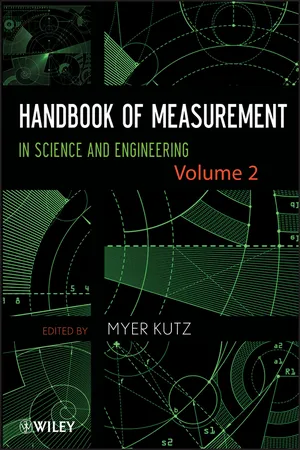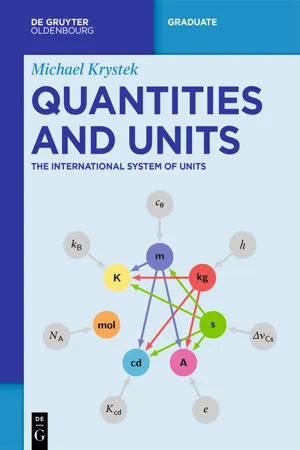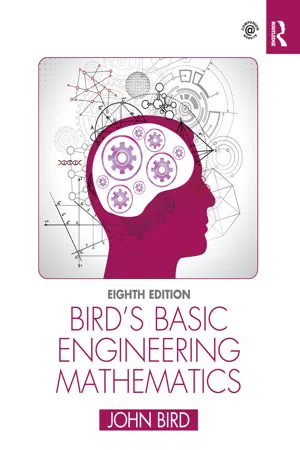Physics
SI Prefixes
SI prefixes are used to denote decimal multiples and submultiples of SI units. They are added to the unit symbol to represent values that are either larger or smaller than the base unit. Common SI prefixes include kilo (k), mega (M), giga (G) for multiples, and milli (m), micro (μ), nano (n) for submultiples. These prefixes make it easier to work with very large or very small measurements.
Written by Perlego with AI-assistance
Related key terms
Related key terms
1 of 4
Related key terms
1 of 3
5 Key excerpts on "SI Prefixes"
- eBook - ePub
- Randall McMullan(Author)
- 2017(Publication Date)
- Bloomsbury Visual Arts(Publisher)
Table R1.1 ) for derived units may be written in index form or with a solidus (/). For example:ms−2 or m/s2SI PrefixesMultiplication factors are used to express large or small values of a unit. These multiples or sub-multiples are shown by a standard set of prefix names and symbols which can be placed before any SI unit, with the exception of the kilogram. Multiples should be chosen so that the numerical value is expressed as a number between 0.1 and 1000. See Table R1.2 .Table R1.1 SI units Table R1.2 SI Prefixes* The standard increment between prefixes is 103 or 10ñ3 but for some units, intermediate prefixes are in common use.The Greek alphabetThe symbols for some quantities and units are taken from the Greek alphabet. See Table R1.3 .Table R1.3 The Greek alphabet Symbols and formulasSome common symbols and formulas used in technical and mathematical expressions are given in Table R1.4 .Table R1.4 Common symbols
CHEMICAL PROCESSES Elements and compoundsSymbolsMeaningΣ sum of > greater than < less than ana raised to the power n √a or a0.5square root of a log x common logarithm (base 10) of x π ‘pi’ = 3.141 593 approx There are millions of different materials in the world but all materials are made up from a few basic elements. There are only 92 elements which occur naturally and about a dozen more which have been produced artificially. All materials in the universe are made from these same elements.In their natural state on our planet, elements do not usually exist by themselves but are found combined with other elements in the form of compounds. Sodium chloride, for example, is a compound made only from the elements sodium and chlorine. Sodium is a reactive silver-coloured metal and chlorine is a poisonous green-coloured gas. Yet the result of their chemical combination is ordinary table salt, which obviously has different properties from its ingredients! - Myer Kutz, Myer Kutz(Authors)
- 2015(Publication Date)
- Wiley(Publisher)
General In general the SI Prefixes should be used to indicate orders of magnitude, thus eliminating nonsignificant digits and leading zeros in decimal fractions and providing a convenient alternative to the powers-of-10 notation preferred in computation. For example,12,300 mm becomes 12.3 m 12.3 × 103 m becomes 12.3 km 0.00123 μA becomes 1.23 nASelection When expressing a quantity by a numerical value and a unit, a prefix should preferably be chosen so that the numerical value lies between 0.1 and 1000. To minimize variety, it is recommended that prefixes representing 1000 raised to an integral power be used. However, three factors may justify deviation:1. In expressing area and volume, the prefixes hecto-, deka-, deci-, and centi- may be required, for example, square hectometer, cubic centimeter.2. In tables of values of the same quantity or in a discussion of such values within a given context, it is generally preferable to use the same unit multiple throughout.3. For certain quantities in particular applications, one particular multiple is customarily used. For example, the millimeter is used for linear dimensions in mechanical engineering drawings even when the values lie far outside the range 0.1-1000 mm; the centimeter is often used for body measurements and clothing sizes.Prefixes in Compound Units2 It is recommended that only one prefix be used in forming a multiple of a compound unit. Normally the prefix should be attached to a unit in the numerator. One exception to this is when the kilogram occurs in the denominator. For example,V/m, not mV/mm, and MJ/kg, not kJ/gCompound Prefixes Compound prefixes formed by the juxtaposition of two or more SI Prefixes are not to be used. For example, use1 nm, not 1 mμm 1 pF, not 1 μμFIf values are required outside the range covered by the prefixes, they should be expressed by using powers of 10 applied to the base unit.Powers of Units- eBook - ePub
Quantities and Units
The International System of Units
- Michael Krystek(Author)
- 2023(Publication Date)
- De Gruyter Oldenbourg(Publisher)
−6 m. However, they do not apply to units that are not SI units. In many countries the use of prefixes is authorized by law.Prefix names are written in capital letters using the font of the surrounding text. They are inseparably attached to the names of the units to which they are prefixed, e. g. millimetres, hectolitres, nanovolts, etc.Prefix symbols, like unit symbols, are always written in upright type (Roman font), regardless of the font used in the surrounding text, without a space between the prefix symbol and the unit symbol. All prefixes for factors greater than 1000 are written in upper case, all others in lower case.Tab. 3.4: Prefix names and prefix symbols for SI units.Factor Name Symbol Factor Name Symbol 1024 yotta Y 0.1 dezi d 1021 zetta Z 10−2 centi c 1018 exa E 10−3 milli m 1015 peta P 10−6 mikro a μ 1012 tera T 10−9 nano n 109 giga G 10−12 piko p 106 mega M 10−15 femto f 103 kilo k 10−18 atto a 102 hecto h 10−21 zepto z 10 deka da 10−24 yokto y aCare must be taken to write the Greek letter μ upright (not italic).The group of characters formed by a unit symbol and a preceding prefix symbol represents a new inseparable unit symbol denoting a multiple or fraction of the corresponding unit. This new unit symbol is therefore treated in the same way as the original unit symbol when calculating with quantity values.Examples:(4.7 μm)2 = (4.7)2 × (10−6 m)2 = 2.209 × 10−11 m215 mg/kg = (15 × 10−3 g)/(103 g) = 1.5 × 10−511.3 g/cm3 = (11.3/10−6 ) × 10−3 kg/m3 = 11 300 kg/m31013.25 hPa = (1013.25 × 102) Pa = 101 325 PaPrefix symbols comprising two or more prefix symbols are not permissible. This rule also applies to two or more prefix names. For the unit of mass, e. g. it is not permissible to write μ - No longer available |Learn more
- Steven Boone, Drew H. Wolfe(Authors)
- 2011(Publication Date)
- Collins Reference(Publisher)
CHAPTER 2Chemical Measurements
I n this chapter, we will first discuss the International Standard of Units, the measurement system used by scientists throughout the world. Then, we will consider uncertainty in measurements and significant figures.2.1 INTERNATIONAL SYSTEM OF UNITSScientists have agreed upon a common set of units and standards, even though the U.S. general public uses a different system. Measurements Chemists make both qualitative and quantitative laboratory measurements. Each quantitative measurement expresses the magnitude, the units or label, and the degree of uncertainty. The SI System—A Metric SystemThe Systéme International d’Unités, or the International System of Units (SI), is the measurement system used in chemistry. The International System is a metric system. In the metric system, the conversion of a measurement from one unit to another requires only the shifting of the decimal point.SI Prefixes To scale a SI unit to the proper size for a measurement, the SI system has a series of prefixes that are appended to units. Exercises 2.1 and 2.2 review some of the more important prefixes. Exercise 2.1 What is the meaning of each of the following SI Prefixes?(a) micro (μ), (b) mega (M), (c) milli (m), (d) deci (d)Solution 2.1(a) 1 × 10-6 ×, (b) 1 × 106 ×, (c) 0.001 ×, (d) 0.1 ×Exercise 2.2What prefix is used for each of the following: (a) 0.01 ×, (b) 1 × 10-9 ×, (c) 1,000 ×, (d) 1 × 10-12 ×?Solution 2.2 (a) centi, c; (b) nano, n; (c) kilo, k; (d) pico, p Base and Derived SI UnitsAll SI units may be derived from seven base units. They include the following: meter (m), unit of length; kilogram (kg), unit of mass; second (s), unit of time; Kelvin (K), unit of temperature; mole (mol), unit of amount of substance; ampere (A), unit of current; and candela (cd), unit of luminous intensity.All other units in the SI system are derived from combinations of seven base units. These are called derived units. Examples of derived SI units include m2 (area), m3 (volume), kg/m3 (density), and kg m2 /s2 - eBook - ePub
- John Bird(Author)
- 2021(Publication Date)
- Routledge(Publisher)
Chapter 8Units, prefixes and engineering notation
In engineering there are many different quantities to get used to, and hence many units to become familiar with. For example, force is measured in newtons, electric current is measured in amperes and pressure is measured in pascals. Sometimes the units of these quantities are either very large or very small and hence prefixes are used. For example, 1000 pascals may be written as 103 Pa which is written as 1 kPa in prefix form, the k being accepted as a symbol to represent 1000 or 103 . Studying, or working, in an engineering discipline, you very quickly become familiar with the standard units of measurement, the prefixes used and engineering notation. An electronic calculator is extremely helpful with engineering notation.Why it is important to understand:its, prefixes and engineering notationAt the end of this chapter you should be able to:- state the seven SI units
- understand derived units
- recognise common engineering units
- understand common prefixes used in engineering
- express decimal numbers in standard form
- use engineering notation and prefix form with engineering units
8.1. Introduction
Of considerable importance in engineering is a knowledge of units of engineering quantities, the prefixes used with units, and engineering notation. We need to know, for example, that80 kV = 80 ×10 3V , which means 80 000 voltsThis is explained in this chapter.and25 mA =25×10A,− 3which means 0 .025 amperesand50 nF =50×10F,− 9which means 0 .000000050 farads8.2. SI units
The system of units used in engineering and science is the Système Internationale d’Unités (International System of Units
Index pages curate the most relevant extracts from our library of academic textbooks. They’ve been created using an in-house natural language model (NLM), each adding context and meaning to key research topics.
Explore more topic indexes
Explore more topic indexes
1 of 6
Explore more topic indexes
1 of 4




